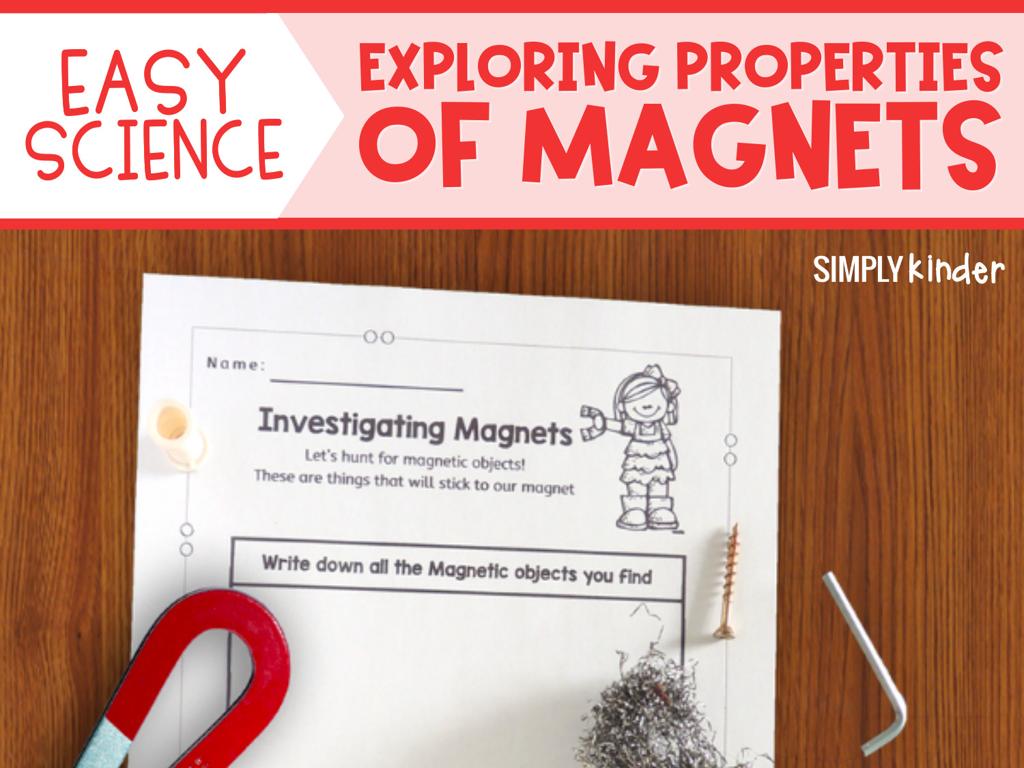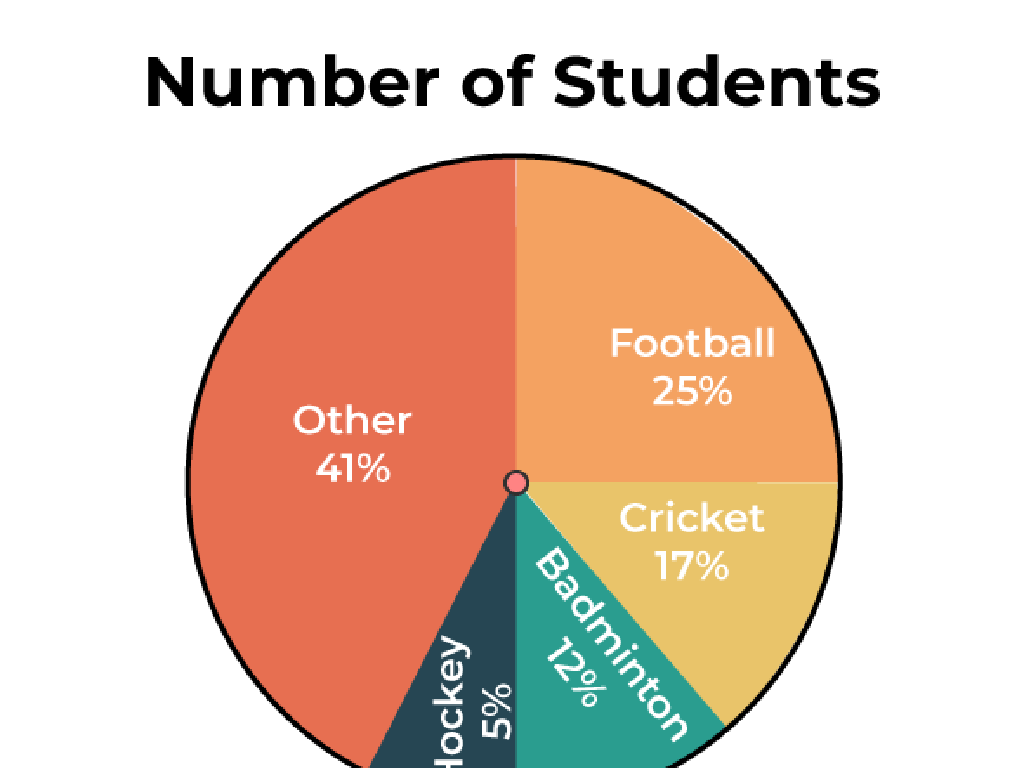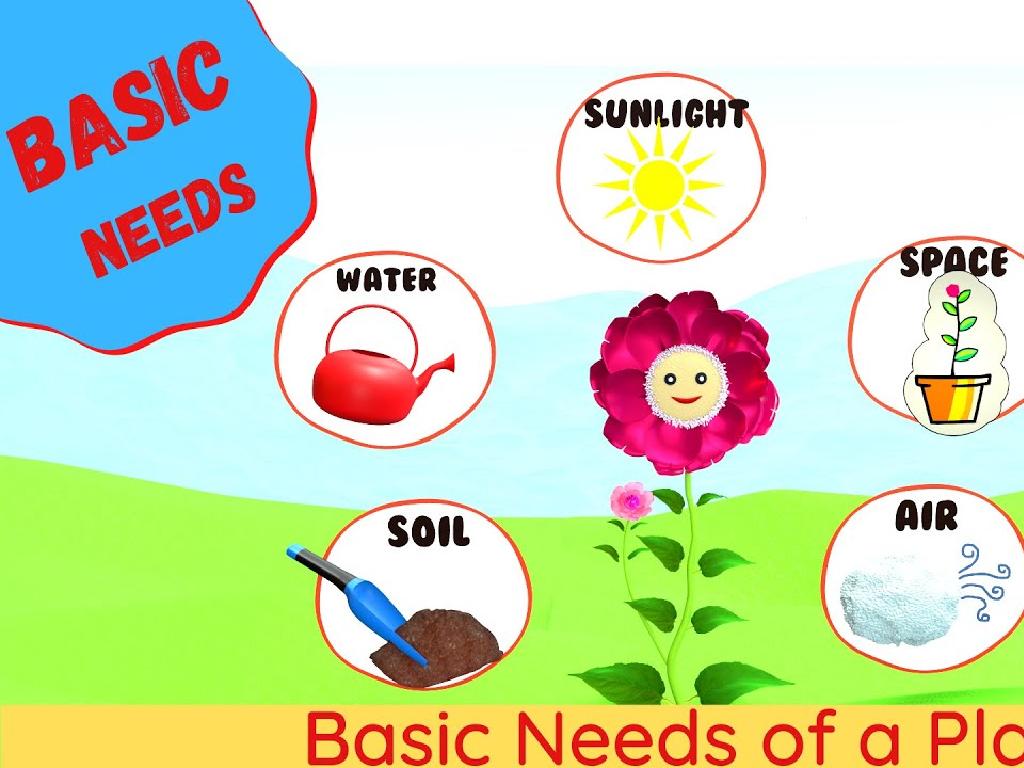Count Sides And Corners
Subject: Math
Grade: Pre-k
Topic: Describe Flat Shapes
Please LOG IN to download the presentation. Access is available to registered users only.
View More Content
Welcome to Shapes: Exploring Flat Shapes
– Greet our little explorers
– Today’s adventure: Flat Shapes
– Flat shapes, like paper cut-outs, have sides & corners
– Identify shapes in the classroom
– Look around to find circles, squares, triangles
– Shapes are everywhere!
|
Begin the class with a warm and enthusiastic greeting to engage the young students. Introduce the concept of flat shapes by comparing them to paper cut-outs, which they are likely familiar with. Encourage the children to look around the classroom and identify shapes they can see, such as the circle of a clock, the square of a window, or the triangle of a play tent. Use this interactive approach to make them aware that shapes are a part of their everyday environment. This will set the foundation for understanding the properties of shapes, such as sides and corners, in a fun and relatable way.
Exploring Flat Shapes
– What are flat shapes?
– Shapes that are flat, like paper, not 3D like a ball
– Sides and corners of shapes
– Edges are sides, and points are corners
– Identifying shapes together
– We’ll look at squares, triangles, and more
– Flat shapes are all around us
|
This slide introduces Pre-K students to the concept of flat shapes, which are two-dimensional and can be found in everyday life. Start by explaining that flat shapes are like drawings on a piece of paper, they are not thick or puffy like a ball. Show them that these shapes have sides, which are the straight edges, and corners, which are the points where two sides meet. Use simple language and real-life examples, such as a window being a rectangle or a slice of pizza being a triangle. Encourage the children to look around their environment to find flat shapes. This will help them understand the concept and see the relevance of shapes in their daily lives.
Meet the Circle: No Sides or Corners
– A circle is round like a ball
– Circles go round and round
– Circles have no sides or corners
– Unlike squares or triangles, circles are smooth
– Circles are unique shapes
– They’re different from other shapes because they’re round all over
|
This slide introduces the concept of a circle to Pre-K students, emphasizing its round shape and lack of sides and corners. Use real-world examples like balls, coins, and clock faces to illustrate circles. Explain that while other shapes have straight edges and points, circles are special because they are continuously round. Encourage the students to look around the classroom and at home for objects that are shaped like circles. This will help them recognize circles in their environment and understand the concept of roundness associated with this shape.
Meet the Square: Counting Sides and Corners
– A square has four sides
– All sides are equal in length
– Squares have four corners
– Let’s count sides and corners together!
– Use a square object, like a book, to count with students.
|
This slide introduces the square to Pre-K students, emphasizing its defining features: four equal sides and four corners. Start by showing a square and pointing to each side, ensuring to highlight that all sides are the same length. Then, point to each corner where the sides meet. Encourage the students to count along with you. Use tangible square objects, like a book or a tile, for a hands-on counting activity. This will help them to visually and physically connect with the concept. The goal is to make the learning experience interactive and engaging, reinforcing their understanding of shapes through repetition and participation.
Meet the Triangle
– A triangle has three sides
– It also has three corners
– Let’s count a triangle’s sides
– Use fingers to count 1, 2, 3 sides
– Now, let’s count its corners
– Use fingers to count 1, 2, 3 corners
|
This slide introduces the basic properties of a triangle to Pre-K students. Start by showing them a triangle and pointing out each side and corner. Encourage the students to use their fingers to count along with you. Make sure to count slowly and clearly, allowing the students to follow and understand. You can also bring in a physical triangle-shaped object for them to touch and count. This tactile experience can help solidify their understanding of the shape. The goal is to make them comfortable with the concept of counting sides and corners of flat shapes, starting with the triangle.
Shape Detectives: Finding Shapes Around Us
– Be a detective: find shapes
– Look around to spot different shapes in the classroom or at home.
– Circle, square, triangle hunt
– Can you find a clock (circle), a window (square), or a sign (triangle)?
– Share your shape finds
– Discuss shapes with friends
– Talk about where you found the shapes and what they look like.
|
This slide is designed to engage Pre-K students in a fun and interactive activity that helps them recognize shapes in their environment. Encourage the children to observe their surroundings and identify objects that correspond to the shapes they’ve learned about, such as circles, squares, and triangles. This activity not only reinforces their understanding of geometric shapes but also enhances their observational skills. After the hunt, facilitate a discussion where each child can share their findings with the class. This collaborative approach allows students to learn from each other and celebrate their discoveries. Provide guidance and support as they describe the shapes and where they found them.
Let’s Play a Game: Counting Sides and Corners!
– Pick a shape from the basket
– Count the sides of the shape
– Sides are the straight lines
– Count the corners of the shape
– Corners are where two sides meet
– Share your findings with the class
|
This interactive game is designed to help Pre-K students recognize and count the sides and corners of different shapes. The teacher will provide a basket filled with various flat shapes. Each student will have a chance to pick one shape and count its sides and corners aloud. Encourage the students to touch and trace the sides and corners with their fingers to help them count. The teacher should prepare a variety of shapes such as triangles, squares, rectangles, and hexagons to ensure a diverse learning experience. It’s important to guide the students through the process and provide assistance if needed. This activity will not only help with shape recognition but also with number counting skills.
Shape Art Activity
– Create your shape masterpiece
– Pick shapes for your picture
– Count sides and corners
– How many sides does a square have?
– Glue shapes and keep counting
– Stick and count each side and corner
|
This slide introduces a hands-on class activity for Pre-K students to reinforce their understanding of shapes by creating art. Encourage the children to select various flat shapes like squares, triangles, and rectangles to create a picture. As they pick each shape, they should count the sides and corners out loud before gluing them onto their artwork. This activity helps solidify their ability to recognize and describe shapes by their properties. For the teacher: Prepare different pre-cut shapes from construction paper. Guide the students through the activity, ensuring they vocalize their counting. Offer assistance with gluing if necessary. Possible variations of the activity could include grouping students to create a larger collaborative shape art piece, using stickers instead of glue for easier manipulation, or incorporating a story where each shape represents a character or object.
Shape Hunt Activity
– Let’s search for shapes in class
– Match objects to learned shapes
– Count sides and corners together
– For example, a book is a rectangle with 4 sides and 4 corners
– Discuss our findings as a group
|
This interactive activity is designed to help Pre-K students apply their knowledge of shapes to the real world. By searching for objects in the classroom that correspond to the shapes they’ve learned, students will practice identifying shapes and counting their sides and corners. Encourage students to work in pairs or small groups to foster teamwork. As they find objects, guide them to count out loud the sides and corners. After the hunt, gather the class and discuss the different shapes found and their attributes. Possible variations of the activity could include using shape flashcards, drawing shapes they find, or even creating a shape collage with pictures of the objects they found during the hunt.
Review and Goodbye: Shapes Adventure
– Excellent work today, class!
– Shapes have sides and corners
– Like squares have 4 sides and 4 corners
– Spot shapes in your world
– Maybe in books, toys, or buildings!
– Excited to see you again!
|
This slide is meant to conclude the lesson on shapes, reinforcing the concept that all shapes have sides and corners. It’s a celebration of the students’ effort and understanding. Encourage the children to continue observing shapes in their environment, reinforcing their learning experience. Remind them to look for shapes at home, in the park, or while traveling. This will help them connect classroom knowledge with the real world. The next class will build on this knowledge, so make sure they’re excited to come back and learn more!






